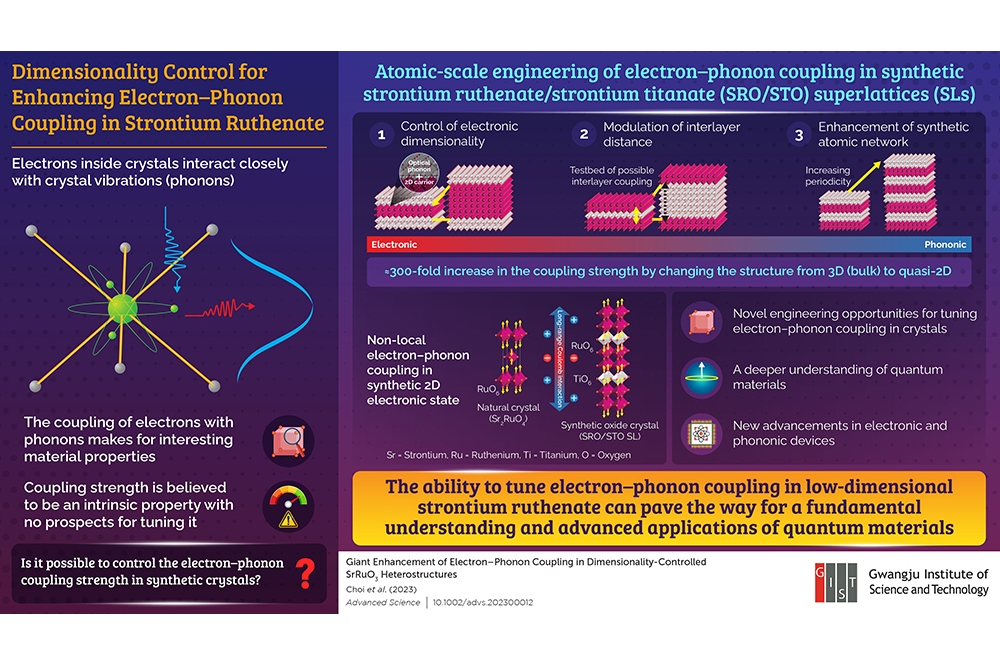Korean team enhances electron–phonon coupling

Atomic-scale engineering brings 300-fold increase in electron–phonon coupling strength in SRO/STO superlattice
Many interesting functional properties of materials with advanced applications often rely on the electron–phonon coupling strength. However, the coupling strength is believed to be an intrinsic material property, which limits potential applications requiring a tunable coupling strength.
In a recent breakthrough, researchers from Korea have managed to engineer this coupling strength in synthetic materials, observing a remarkable 300-fold enhancement in strontium ruthenate with reduced dimensionality.
Electrons inside crystals interact closely with phonons, defined as the discrete unit of crystal vibrations. The electron–phonon coupling strength is an important fundamental physical quantity in solid state physics, determining electrodynamic behaviours and correlated functionalities of a material. This, in turn, makes for interesting material properties with advanced applications. However, the coupling strength is typically considered an intrinsic material property without any provision for controlling it for desired applications.
Against this backdrop, a group of researchers, led by Jong Seok Lee of the Gwangju Institute of Science and Technology in Korea has now demonstrated the ability to tune this coupling and achieve a massive enhancement in its strength using synthetic heterostructures of transition metal oxides. The researchers have detailed their findings in a paper made available online on 13th April 2023 and published in Volume 10, Issue 16 of Advanced Science on 2nd June 2023.
“Unfortunately, electron–phonon coupling is innately determined by the crystal structure of a solid, hence it was crucial to find a new method to control or enhance the coupling,” says Lee, explaining the motivation behind the present work.
In their study, the researchers demonstrated an atomic-scale engineering of the electron–phonon coupling strength in synthetic strontium ruthenate/strontium titanate (SRO/STO) superlattices (a periodic structure of layers of two materials). They achieved this feat by artificially heterostructuring the SRO/STO system. This entailed controlling the electronic dimensionality, modulating the interlayer distance, and increasing the periodicity of the synthetic atomic network.
Remarkably, a reduction in the dimensionality from 3D (bulk) to quasi-2D led to a 300-fold increase in the electron–phonon coupling strength. The researchers attributed this huge enhancement to the non-local nature of the coupling in synthetic SRO/STO superlattices, which becomes prominent in the 2D electronic state. In addition, they found that the electrons in the 2D SRO layers coupled to optical phonons (vibrations capable of absorbing or emitting light) as revealed by the temperature-dependent electron–phonon coupling measurements, which further contributed to the coupling enhancement.
This development paves the way for novel engineering opportunities for tuning electron–phonon coupling strength in crystals. In addition, it facilitates a deeper understanding of quantum materials. “The electron–phonon coupling is closely related not only to the performance of thermoelectric devices but also the energy harvesting efficiency of solar cells. Currently, researchers are struggling to solve the overheating issue in nano-scale devices. This problem limits the performance of such devices. The present work can contribute to solving the overheating issue, resulting in an improved performance of nano-scale devices,” speculates Lee.
Overall, these findings provide new insights into the tuning knobs available in synthetic crystals for controlling the electron–phonon coupling strength, useful not only for advancing technology but also for a deeper understanding of quantum phenomena like strongly coupled charge and lattice dynamics in quantum materials.
Reference
'Giant Enhancement of Electron–Phonon Coupling in Dimensionality-Controlled SrRuO3 Heterostructures'; Advanced Science (2023)


































